Types of Asphalt Shingles: Which One Should You Choose?

When planning a roof replacement or upgrade, one of the first decisions you’ll face is choosing between the different types of asphalt shingles. From budget-friendly 3-tab options to high-end luxury designs, each type offers distinct advantages depending on your goals, property type, and local climate.
In this article, we’ll break down the most common asphalt shingle types—what they’re made of, how long they last, how they perform in tough conditions, and which ones make the most sense for your home or building.
Whether you’re a homeowner trying to boost curb appeal or a property manager in a hurricane-prone region, this guide will help you choose confidently.
Here’s what we’ll cover:
- Why Shingle Type Matters for Your Roof
- Overview of the Main Asphalt Shingle Types
- In-Depth Comparison of Asphalt Shingle Types
- How to Choose the Right Shingle for Your Project
- Other Asphalt Shingle Variants
- What to Ask Your Contractor About Shingle Types
- Final Thoughts: Finding the Right Fit for Your Roof
Let’s start by looking at why the type of shingle you choose makes such a big difference.
Why Shingle Type Matters for Your Roof
Choosing the right asphalt shingle type isn’t just about picking a color or sticking to your budget—it’s a decision that directly affects your roof’s performance, longevity, curb appeal, and long-term maintenance needs.
Whether you’re replacing a weather-worn residential roof or upgrading a commercial property, understanding how shingle types differ can help you avoid costly mistakes and ensure the best outcome for your investment.
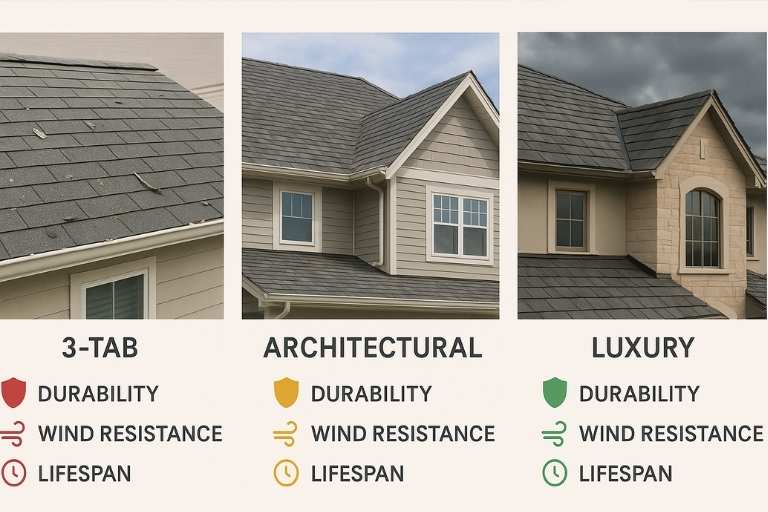
Performance and Lifespan
Each type of asphalt shingle is engineered with specific features that influence how it holds up under stress. For example, architectural shingles are typically thicker and layered, offering better wind resistance and durability compared to standard 3-tab shingles. Luxury (or designer) shingles go even further, mimicking the look of slate or wood shakes while delivering superior strength and extended warranties.
Choosing a lower-tier shingle for a high-exposure area—like a flat commercial rooftop or a storm-prone coastal home—could lead to premature failure and more frequent repairs.
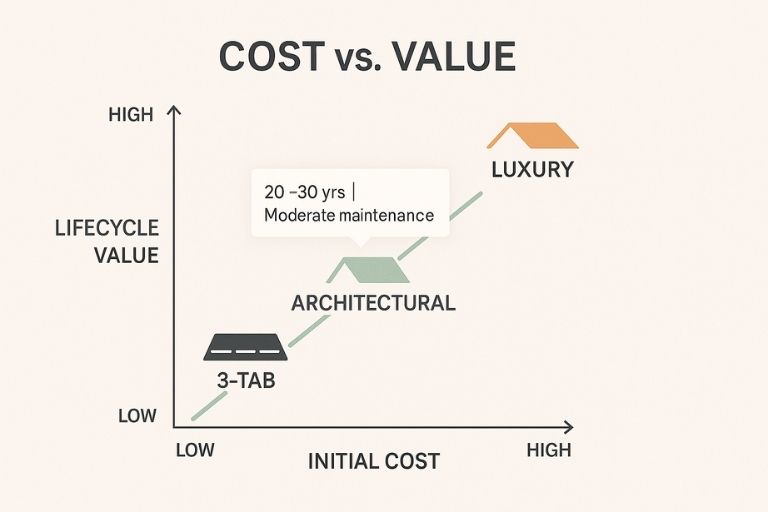
Cost vs. Value
While upfront costs vary, the true value of a shingle type is found in its lifecycle cost—how long it lasts, how well it holds up in your environment, and how much maintenance it requires. For instance, 3-tab shingles are the most affordable option but may need replacement sooner, whereas architectural shingles strike a balance between cost and long-term durability.
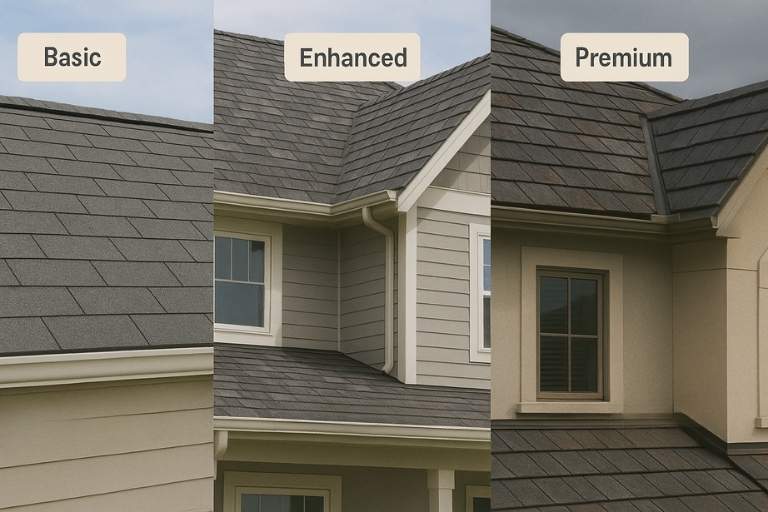
Design and Curb Appeal
Aesthetic impact is another important consideration, especially for homeowners looking to boost resale value or maintain a certain neighborhood standard. Architectural and luxury shingles offer deeper shadow lines, a more dimensional look, and a wider range of color choices, making them a popular choice for upscale homes.
Commercial properties can also benefit from a polished, consistent roof design that enhances professional appearance and branding.
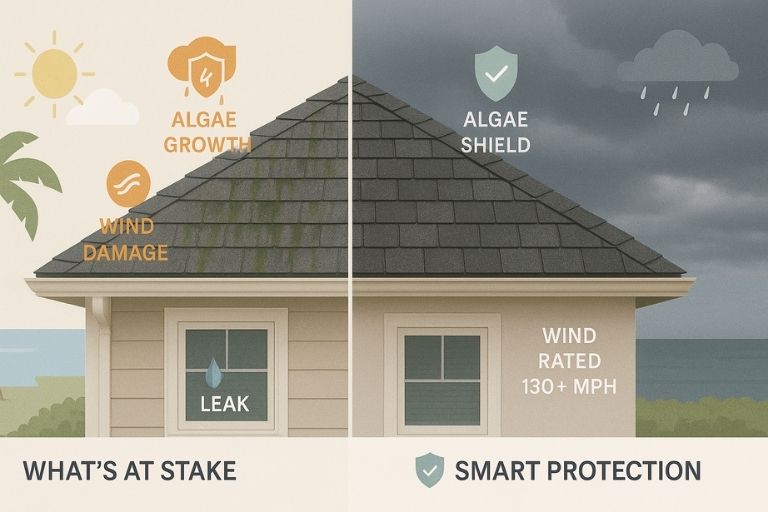
Climate Considerations for Florida and Similar Regions
In high-humidity, high-wind environments like Florida, not all shingles perform equally. To better understand which products offer the best performance in these challenging conditions, check out our guide to the Best Asphalt Shingles for Florida Climate.
Choosing a product with built-in algae resistance, higher wind uplift ratings, and impact resistance is essential. For example, fiberglass-based shingles are generally lighter and more fire-resistant than older organic mat options, making them better suited to today’s environmental demands.
You can learn more in this guide to algae-resistant shingles and why they’re especially important in humid climates.
What’s at Stake When Choosing the Wrong Shingle Type:
- Reduced roof lifespan and premature failure
- Increased maintenance and repair costs
- Lower property value or poor visual appeal
- Higher vulnerability to storm damage and leaks
- Limited or voided manufacturer warranties
Takeaway: The type of asphalt shingle you choose can significantly affect the performance, protection, and aesthetics of your roof. Making an informed decision based on your property’s needs, local climate, and long-term goals is essential for maximizing your roofing investment.
Overview of the Main Asphalt Shingle Types
Asphalt shingles come in three primary categories—3-tab, architectural, and luxury—each designed to meet different aesthetic preferences, performance expectations, and budget constraints.
Understanding how these shingle types differ at a high level sets the foundation for choosing the right fit for your home or commercial property.
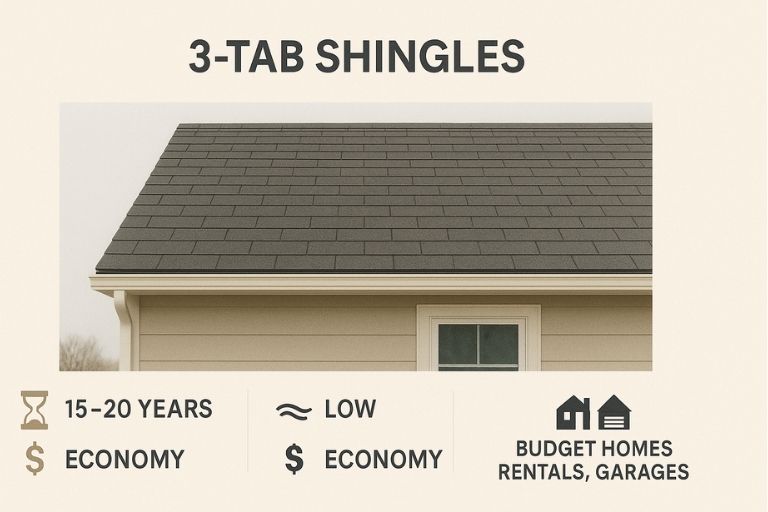
3-Tab Shingles
3-tab shingles are the most basic and budget-friendly asphalt roofing option. Named for their uniform three-tab appearance, these shingles lay flat and offer a clean, traditional look. They’re lightweight and easy to install, making them a common choice for homeowners focused on upfront cost savings or for properties with straightforward, low-slope roofs.
However, they have a shorter lifespan—typically around 15–20 years—and offer less resistance to high winds and weather extremes, which can be a drawback in regions like Florida. Learn more about Asphalt Shingle Roofing
- Best for: Budget-conscious homeowners, rental properties, garages
- Price Tier: $ (Economy)
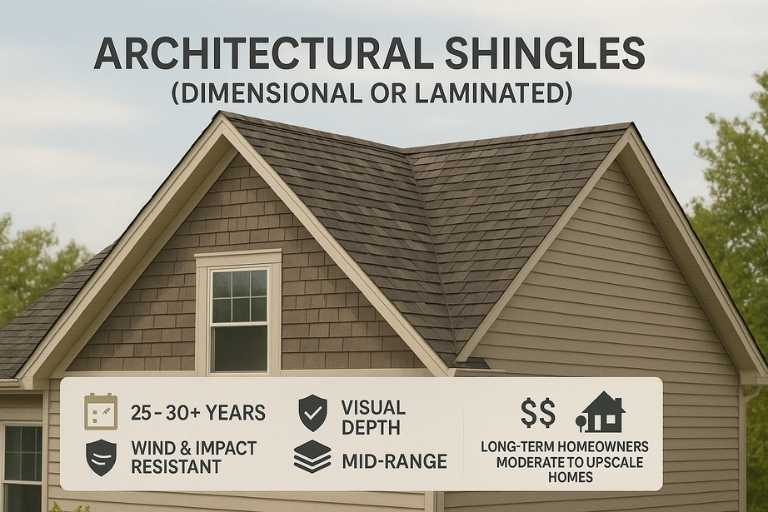
Architectural Shingles (Dimensional or Laminated)
Architectural shingles, also known as dimensional or laminated shingles, feature a thicker, multi-layered design that gives the roof a more textured, high-end appearance. These shingles are more durable than 3-tab, often lasting 25–30 years or more, and typically come with stronger wind and impact resistance ratings.
Their layered construction adds visual depth, making them a popular mid-range option for homeowners looking to balance aesthetics and longevity.
If you’re unsure whether 3-tab or architectural shingles are the better fit for your project, this in-depth comparison of 3-tab vs. architectural shingles can help clarify the differences.
- Best for: Long-term homeowners, moderate to high-end residential properties
- Price Tier: $$ (Mid-range)
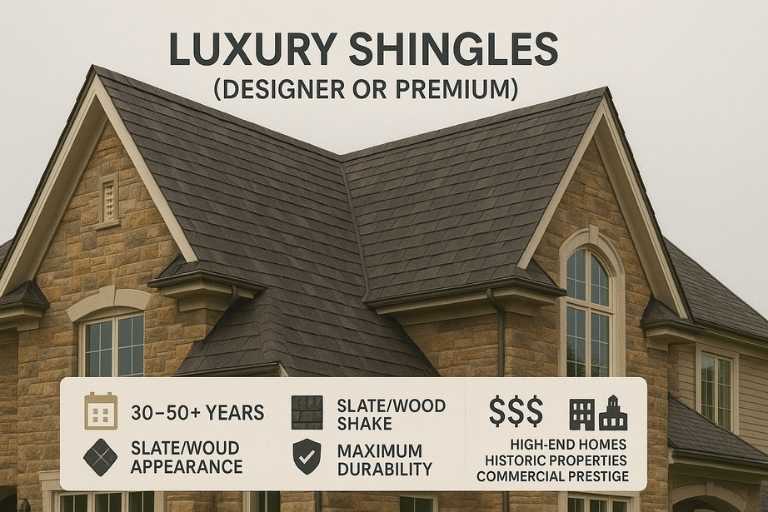
Luxury Shingles (Designer or Premium)
Luxury shingles are the top-tier asphalt option, designed to replicate the look of slate or cedar shake at a fraction of the weight and cost. These shingles are significantly thicker and heavier, offering maximum durability, longest lifespan, and enhanced curb appeal.
Luxury shingles are often used on upscale homes or buildings where design and prestige are priorities. If you’re considering this premium option, explore our guide to luxury asphalt shingles for upscale homes for design tips, material comparisons, and long-term benefits.
- Best for: High-end homes, historic properties, premium commercial buildings
- Price Tier: $$$ (Premium)
In-Depth Comparison of Asphalt Shingle Types
Now that we’ve introduced the three primary categories of asphalt shingles—3-tab, architectural, and luxury—let’s explore how they differ across key decision-making criteria.
From the materials they’re made of to how well they hold up over time, understanding these details will help you make the most informed choice for your property.
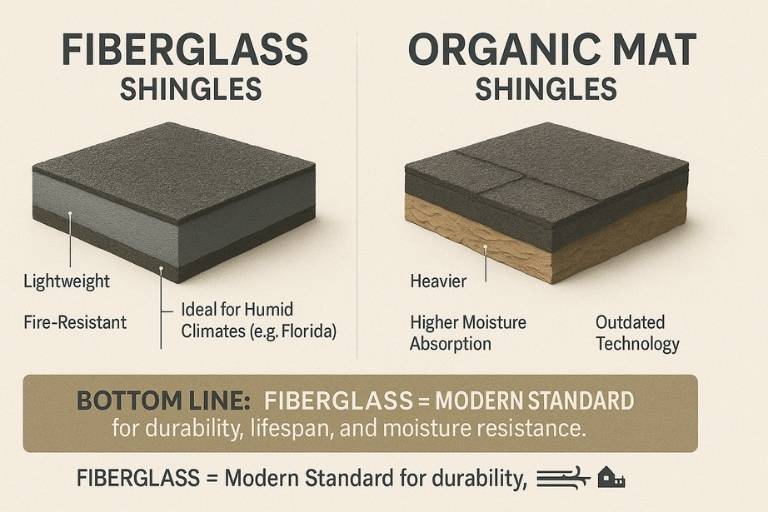
Material Composition
Most modern asphalt shingles are made from a fiberglass mat base topped with asphalt and mineral granules. However, there are two core substrate types to be aware of:
- Fiberglass Shingles:
The most common and widely used today. They’re lightweight, fire-resistant, and absorb less moisture than older organic mat versions. Ideal for humid and high-rainfall climates like Florida. - Organic Mat Shingles:
Made with recycled paper materials and coated with asphalt. These are heavier and were once valued for durability, but they are largely outdated due to their higher moisture absorption and susceptibility to warping. For a deeper dive, read this comparison of fiberglass vs. organic mat shingles.
Bottom Line: Fiberglass is the standard for new installations due to its superior weather resistance, weight, and lifespan.
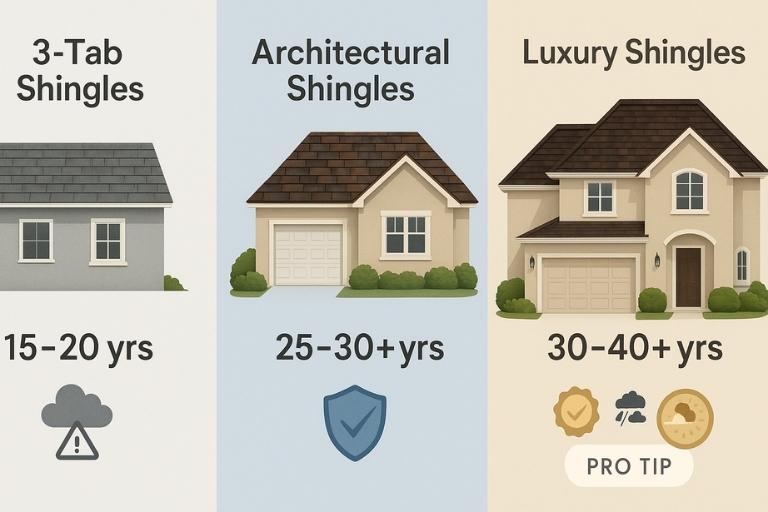
Durability & Lifespan
The durability and expected lifespan of asphalt shingles vary significantly by type:
- 3-Tab Shingles: Typically last 15–20 years with basic protection. Less resistant to wind and impact.
- Architectural Shingles: Offer 25–30+ years of performance with layered construction that enhances strength.
- Luxury Shingles: Often exceed 30–40 years and come with premium warranties. Built for resilience and longevity.
Learn more about the typical lifespan of asphalt shingles and what factors can shorten or extend it in this in-depth guide.
Pro Tip: In areas prone to storms or extreme sun exposure, investing in a higher-tier shingle can pay off in fewer repairs and longer roof life. Learn more about the factors that influence asphalt shingle lifespan. Also consider Storm Damage Repair services if your area is especially at risk.
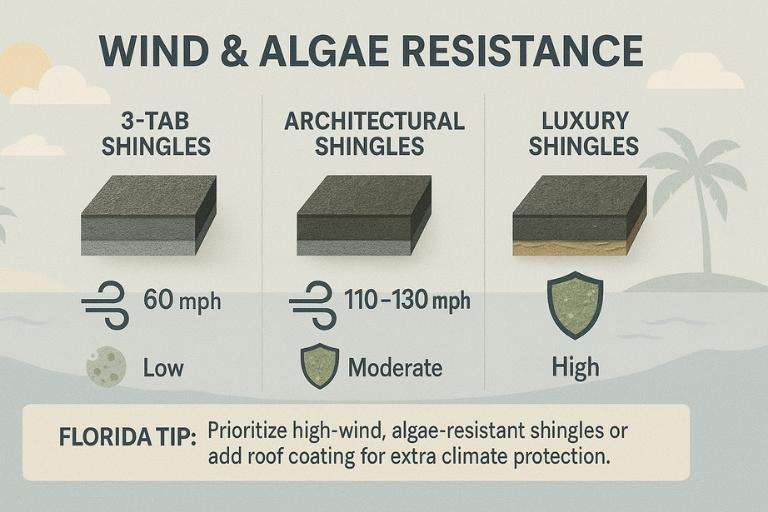
Wind & Algae Resistance
Asphalt shingles are rated for wind uplift and resistance to algae staining:
- 3-Tab: Generally rated up to 60 mph wind resistance; algae resistance is minimal unless treated.
- Architectural: Rated 110–130 mph (upgradeable with proper installation); better algae-resistant granules.
- Luxury: Designed for maximum wind resistance (up to 150+ mph in some products) and superior algae protection.
Florida Consideration: Homes in coastal or hurricane zones should prioritize shingles with higher wind ratings and built-in algae resistance to combat the climate’s challenges. You might also consider adding Roof Coating to further enhance waterproofing and UV resistance.
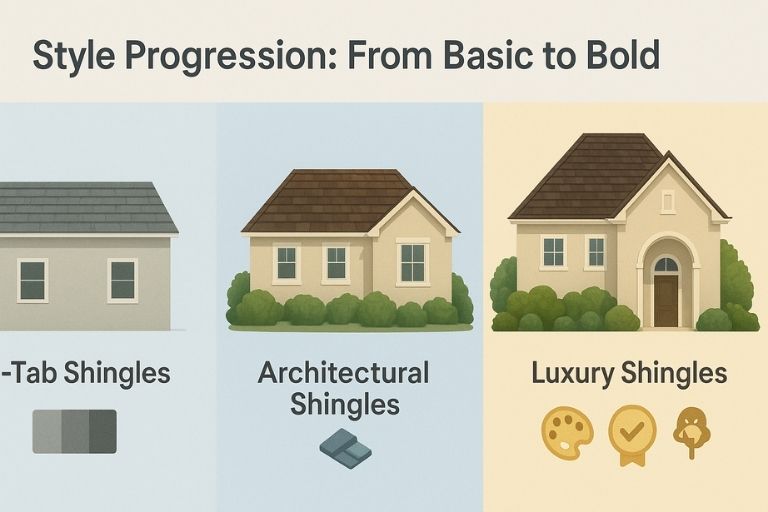
Aesthetics & Design Options
- 3-Tab Shingles: Flat, uniform appearance with limited color options.
- Architectural Shingles: Textured and dimensional, offering a more upscale, layered look.
- Luxury Shingles: Deep shadow lines, designer patterns, and options that replicate slate or cedar shake.
These visual differences affect not only curb appeal but also how well the roof complements the overall architectural style of a home or commercial building.
Cost and Value Over Time
Initial costs differ significantly by type—but value includes more than just price:
| Shingle Type | Upfront Cost | Lifespan | Maintenance | Overall Value |
| 3-Tab | Low | 15–20 years | Higher | Budget-friendly, short-term solution |
| Architectural | Moderate | 25–30 years | Medium | Best balance of cost and performance |
| Luxury | High | 30–40+ years | Low | Long-term investment with premium appeal |
Cost-Saving Insight: While 3-tab shingles may be cheaper upfront, architectural and luxury options tend to offer better cost-per-year value, especially when factoring in repairs, replacements, and resale impact.
Takeaway: Choosing the right asphalt shingle type means weighing material quality, durability, climate resilience, design impact, and long-term value. Use this breakdown to prioritize what matters most to your property’s function, aesthetics, and future maintenance costs.
How to Choose the Right Shingle for Your Project
With multiple asphalt shingle types available, selecting the right one isn’t always straightforward. The best choice depends on your specific goals—whether you’re focused on saving money, maximizing lifespan, improving curb appeal, or meeting the demands of a commercial property.
Here’s how to match your roofing needs to the ideal shingle type.
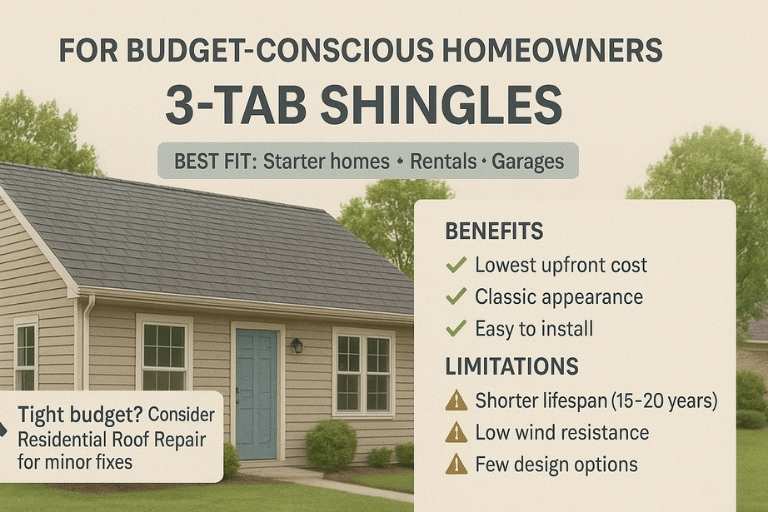
For Budget-Conscious Homeowners
Best Fit: 3-Tab Shingles
If affordability is your top priority, 3-tab shingles offer a practical solution. Their simple design makes them cost-effective to manufacture, install, and replace, making them a popular choice for:
- Starter homes
- Rental properties
- Garages or secondary structures
Benefits:
- Lowest upfront cost
- Clean, classic look
- Easy to source and install
Limitations:
- Shorter lifespan (15–20 years)
- Limited wind and impact resistance
- Fewer color and texture options
Ideal Scenario: You need to re-roof on a tight budget and don’t plan to stay in the home long-term—see our guide on deciding between roof repair or replacement for more insight. For minor issues, consider Residential Roof Repair as an alternative.
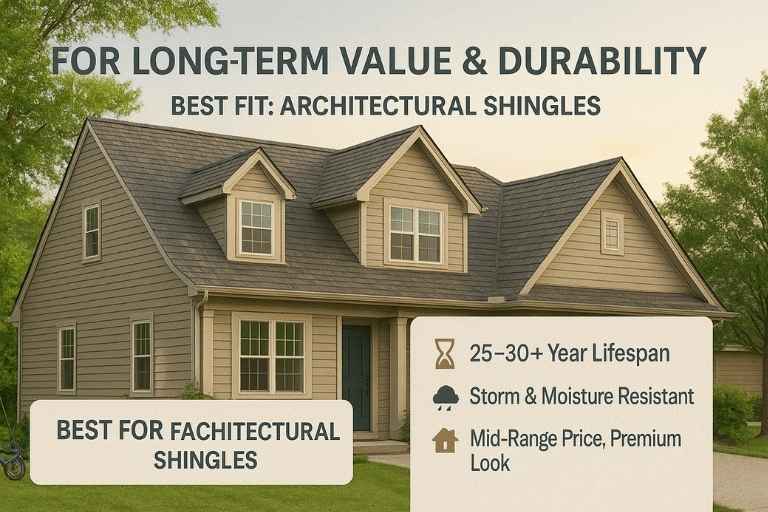
For Long-Term Value & Durability
Best Fit: Architectural Shingles
Architectural shingles strike the best balance between price, performance, and appearance. Learn more about their long-term benefits and why they’re worth the extra cost in this detailed article on architectural shingles advantages.
They’re built with multiple layers for enhanced thickness, improving strength and resistance to wind, moisture, and impact. This makes them a smart investment for:
- Long-term homeowners
- Families in storm-prone area
- Moderate to high-end residential properties
Why They Work:
- Longer lifespan (25–30+ years)
- Enhanced weather protection
- Mid-range pricing with premium feel
Ideal Scenario: You want a durable, attractive roof that boosts value without breaking the bank.
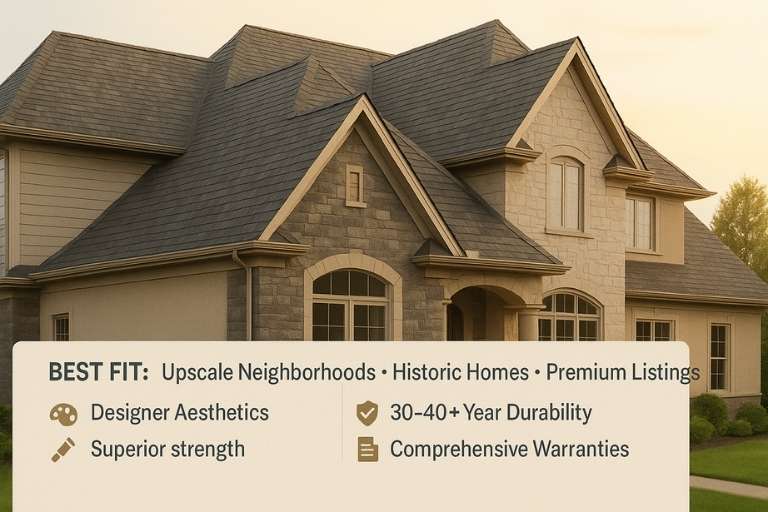
For Curb Appeal or High-End Properties
Best Fit: Luxury Shingles
If design and distinction are your goals, luxury shingles provide the most upscale roofing option. Their intricate textures and profiles replicate the look of slate or cedar shake and can significantly elevate the appearance of your property.
Perfect For:
- Upscale neighborhoods
- Historic homes
- High-value real estate listings
Why They’re Worth It:
- Bold, designer aesthetics
- Superior strength and longevity (30–40+ years)
- Comprehensive manufacturer warranties
Ideal Scenario: You’re prioritizing curb appeal, resale value, or simply want a roof that stands out and lasts decades.
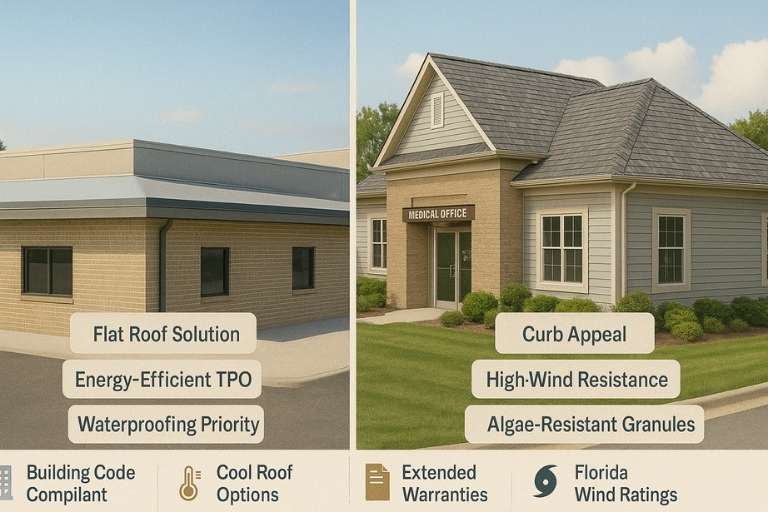
Commercial Roofing Considerations
Tailored Fit: Varies by Roof Design and Climate
Commercial properties have unique needs, and the right shingle type depends on both the slope of the roof and environmental conditions—learn more about best shingles for commercial roofs.
- Flat or low-slope roofs: often require alternatives like Flat Roof Services instead of standard shingles. (e.g., TPO, modified bitumen)
- Steep-slope roofs on retail or office spaces: Architectural or luxury shingles offer strong curb appeal and durability
- Climate factors: In states like Florida, prioritize shingles with high wind resistance and algae-resistant granules
Key Considerations:
- Compliance with building codes and insurance requirements
- Energy efficiency (look for cool roofing options)
- Extended warranties for large-scale installations
Ideal Scenario: You’re managing a commercial upgrade and need materials that balance appearance, resilience, and compliance.
Decision-Making Checklist (Suggested Visual)
- What’s your budget?
- How long do you plan to own or manage the property?
- Is curb appeal a high priority?
- Is the location prone to wind, storms, or algae?
- Are there HOA, code, or warranty requirements to consider?
- What type of slope or structure are you working with?
Takeaway: By aligning your roofing goals with the strengths of each shingle type, you’ll be better positioned to make a choice that delivers the durability, style, and value your project demands—whether it’s a modest home upgrade or a major commercial renovation.
Other Asphalt Shingle Variants
While 3-tab, architectural, and luxury shingles dominate today’s residential and commercial roofing markets, a few other asphalt shingle variants are worth knowing—especially if you’re evaluating older roofing systems or considering specialty upgrades.
These options are less commonly used but may still appear in certain regions or niche applications.
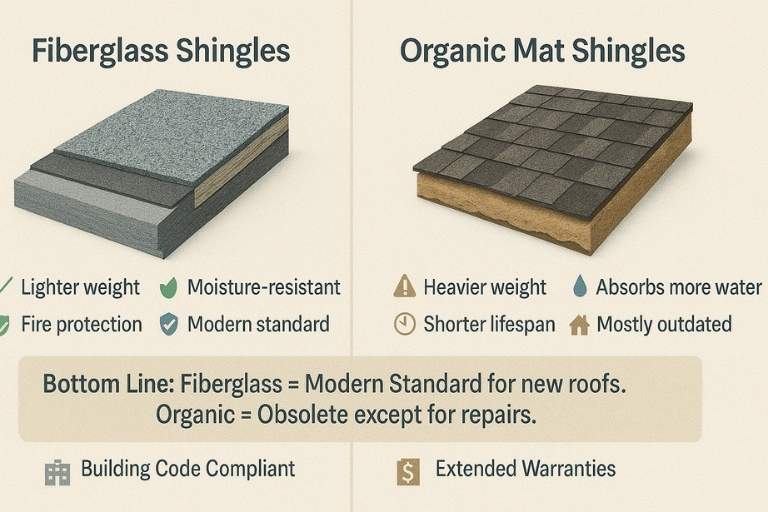
Fiberglass vs. Organic Mat Shingles
The key difference between fiberglass and organic shingles lies in their core structure:
- Fiberglass Shingles are made with a fiberglass mat and coated in asphalt and mineral granules. They’re lighter, more moisture-resistant, and offer better fire protection. Today, they are the industry standard for most new roofing projects.
- Organic Mat Shingles use a cellulose-based mat (often made from recycled paper) saturated with asphalt. These were common in older roofing systems but are now largely phased out due to higher water absorption, heavier weight, and shorter lifespan.
Bottom line: Unless you’re replacing or repairing an existing roof with organic shingles, fiberglass is the modern go-to.
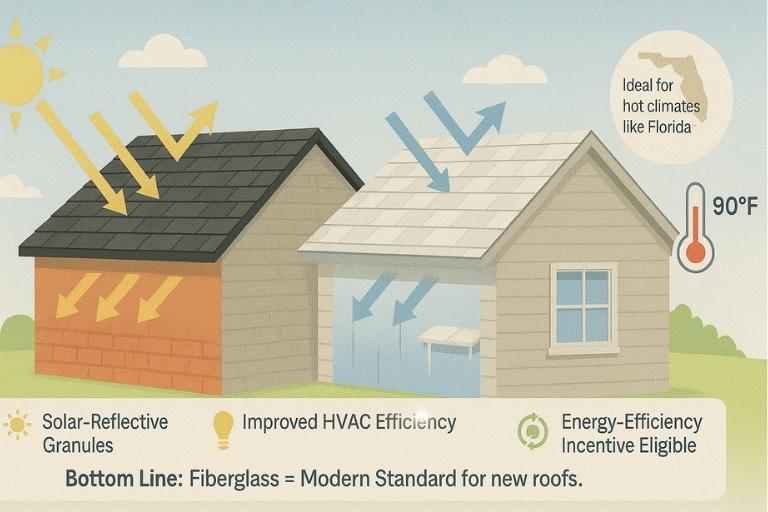
Cool Roofing and Energy-Efficient Shingles
Some asphalt shingles are designed with solar-reflective granules that reduce heat absorption. These cool roof shingles can help lower indoor temperatures, improve HVAC efficiency, and reduce energy bills—especially important in sun-intense regions like Florida or the southern U.S. If energy savings are a goal, also explore options like Solar Panel Installation.
- Available mainly in lighter colors and higher-end product lines
- May qualify for energy efficiency incentives or meet green building standards
- Ideal for eco-conscious homeowners or commercial buildings aiming for sustainability goals, reflective roofing options can make a noticeable impact on long-term energy savings.
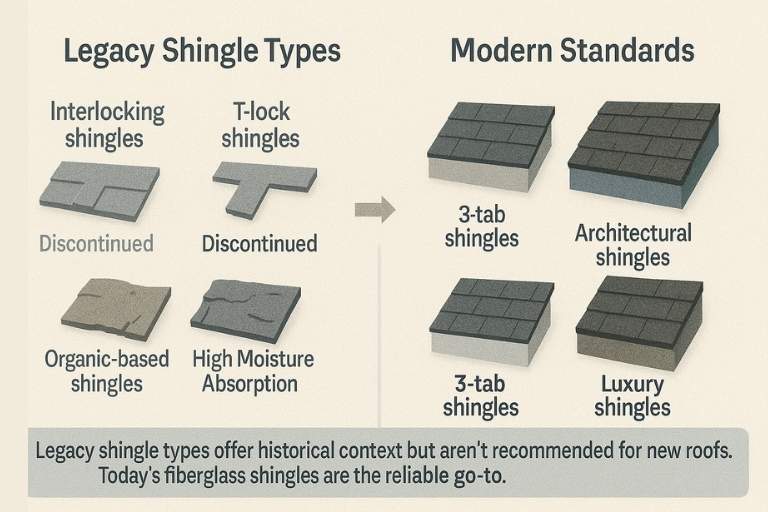
Outdated or Niche Shingle Types
A few other asphalt-based roofing products exist but are rarely used in modern construction:
- Interlocking shingles: Once popular for high-wind areas but now replaced by architectural or designer options with better adhesion systems.
- T-lock shingles: Discontinued due to performance and manufacturing limitations.
- Organic-based specialty lines: Mostly discontinued in favor of fiberglass versions.
Takeaway: While these lesser-known or legacy shingle types can offer context in specific roofing scenarios, today’s fiberglass-based 3-tab, architectural, and luxury shingles provide the most reliable and widely supported solutions for most projects.
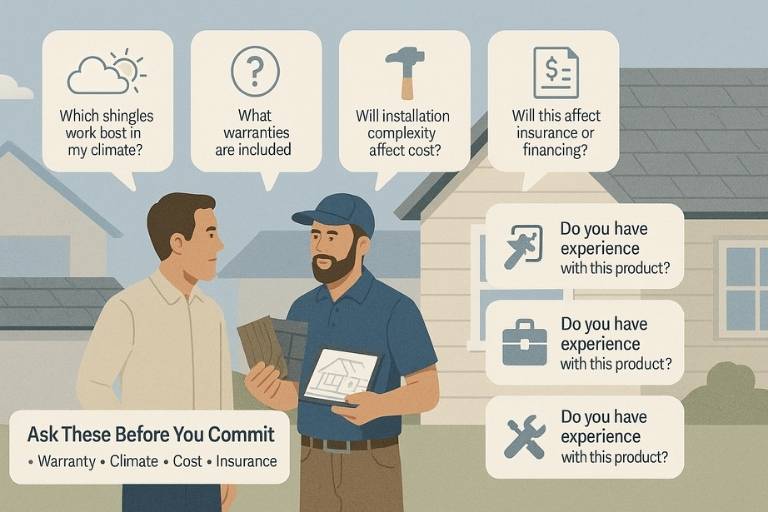
What to Ask Your Contractor About Shingle Types
Once you’ve narrowed down your options, the next step is having an informed conversation with your roofing contractor. Asking the right questions can help you validate your choice, uncover additional considerations based on your local environment, and avoid costly surprises down the line.
Here are some key questions to bring to the table:
1. Which Shingle Type Is Best for My Local Climate?
Florida homeowners, for example, need shingles that can withstand high humidity, intense sun, and hurricane-force winds. A seasoned contractor should be able to recommend products with high wind resistance ratings and algae-resistant granules that perform well in your region.
2. What Warranties Are Available with This Shingle Type?
Different shingles come with varying manufacturer warranties—some lasting 20 years, others offering 40+ years or even limited lifetime coverage. Be sure to ask:
- Does the warranty cover wind or algae damage?
- Is the warranty transferable if I sell my home?
- Are enhanced warranties available with certified installation?
A reputable contractor, like RayPro Roofing & General Contracting, will clearly explain warranty tiers and ensure your roof is eligible for the best coverage available.
3. How Does the Shingle Type Affect Installation and Cost?
Installation complexity can vary. Luxury shingles, for example, are thicker and heavier, which may increase labor time and material handling. Ask your contractor:
- Are there added installation costs based on the shingle type?
- Will roof reinforcement be needed for heavier shingles?
- How does installation time compare between options?
Also, be sure to review this step-by-step guide to shingling a roof if you’re curious about how different materials affect installation complexity and time.
4. Will My Insurance or Financing Be Affected by My Shingle Choice?
Some insurers offer discounts for shingles with higher wind ratings or impact resistance. Similarly, energy-efficient (cool roof) shingles may qualify for green building incentives or financing perks. Ask your contractor:
- Are there insurance savings tied to shingle upgrades?
- Can you assist with paperwork for financing or rebates?
- Will this choice increase the appraised value of my home or building?
5. Do You Have Experience Installing This Shingle Type?
Not all contractors are certified or experienced with every asphalt shingle product. Look for providers with a proven track record, especially for high-end or specialty installations. RayPro, for example, has experience installing all major asphalt shingle types across a range of property types and climates in 17 states.
Takeaway: The right contractor will not only install your roof correctly but help guide your decision based on performance, warranty, aesthetics, and value. Use these questions to ensure you’re working with someone who understands your needs—and can deliver lasting results.
Final Thoughts: Finding the Right Fit for Your Roof
Choosing the right type of asphalt shingle is a decision that carries both short-term and long-term implications. It affects not only how your roof performs but also how it looks, how long it lasts, and how much it costs to maintain over time.
While the options may seem overwhelming at first, the right choice becomes clearer when you align the product with your property type, budget, climate, and personal goals.
Here’s a quick recap of the key decision factors to keep in mind:
- Budget and timeframe: 3-tab shingles are cost-effective for short-term needs; architectural and luxury shingles offer better long-term value.
- Durability and performance: Architectural shingles strike a balance between strength and affordability, while luxury shingles deliver top-tier protection and longevity.
- Aesthetic priorities: For visual appeal and high-end finishes, luxury shingles can elevate curb appeal and even increase resale value.
- Climate concerns: In hot, humid, or storm-prone areas, prioritize shingles with high wind ratings and algae resistance—features more common in architectural and luxury lines.
- Property type and usage: Residential roofs benefit from layered aesthetics, while commercial buildings may need more focus on compliance, slope, and scale.
Ultimately, there’s no one-size-fits-all answer. The best asphalt shingle for your roof is the one that fits your specific needs—whether that’s extending the life of a family home, boosting the professional image of a retail space, or navigating insurance and code requirements in a coastal environment.
By understanding the strengths and limitations of each shingle type, and by asking the right questions, you’re well-equipped to make a confident, informed choice that protects your property and enhances its value for years to come.
If you’re ready to explore your options or need professional input, don’t hesitate to Contact Us for a personalized consultation.
Frequently Asked Questions
The main difference lies in design, thickness, and durability. 3-tab shingles are flat and uniform, offering a clean but basic look with a typical lifespan of 15–20 years. Architectural shingles, also called dimensional or laminated shingles, are thicker with a layered appearance, offering enhanced wind resistance and a longer lifespan of 25–30+ years.
They also provide better curb appeal and are more resistant to harsh weather.
Luxury shingles are a premium option designed to replicate the appearance of slate or cedar shake at a lower cost and weight. They’re thicker, more durable, and often come with longer warranties. They are worth the investment if you prioritize high-end aesthetics, long-term durability (30–40+ years), or need a roofing solution that complements a historic or upscale property.
For budget-conscious projects, however, architectural shingles often provide a solid middle ground.
Luxury shingles typically have the longest lifespan—up to 40 years or more with proper installation and maintenance. Architectural shingles follow closely, lasting around 25–30 years. 3-tab shingles tend to have the shortest lifespan, usually around 15–20 years, making them better suited for short-term or low-budget needs.
For Florida’s humid, storm-prone environment, architectural or luxury shingles are recommended. Look for options with high wind ratings (110–130+ mph), algae-resistant granules, and strong manufacturer warranties. Fiberglass-based shingles are also preferred over organic mat types due to their superior moisture resistance and longevity in high-humidity areas.
Technically, it’s possible, but it’s rarely recommended. Mixing 3-tab with architectural or luxury shingles can lead to visual inconsistencies, uneven wear, and may void manufacturer warranties. Additionally, different types may require different installation techniques and materials. For uniform performance and appearance, it’s best to stick with one shingle type across the entire roof.
